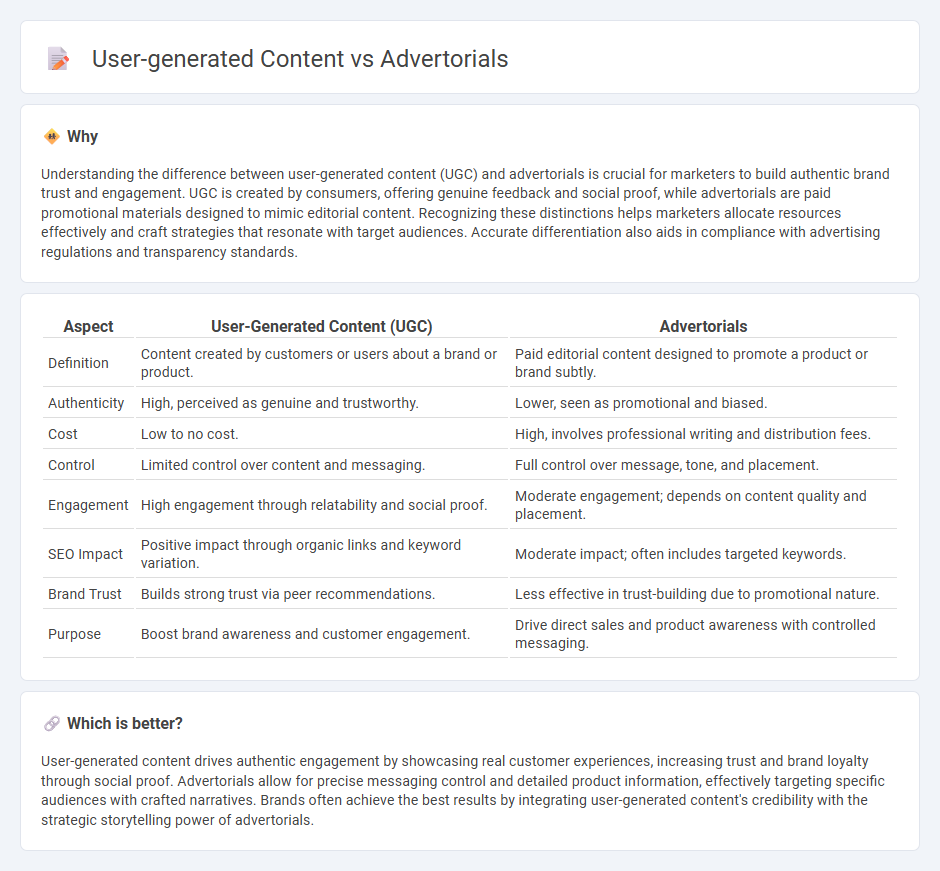
User-generated content (UGC) creates authentic engagement by leveraging real customers' experiences, enhancing brand trust through relatable and diverse perspectives. Advertorials, crafted and controlled by the brand, strategically blend promotional messaging with editorial-style content to influence consumer perception. Explore how combining UGC and advertorials can optimize your marketing strategy.
Why it is important
Understanding the difference between user-generated content (UGC) and advertorials is crucial for marketers to build authentic brand trust and engagement. UGC is created by consumers, offering genuine feedback and social proof, while advertorials are paid promotional materials designed to mimic editorial content. Recognizing these distinctions helps marketers allocate resources effectively and craft strategies that resonate with target audiences. Accurate differentiation also aids in compliance with advertising regulations and transparency standards.
Comparison Table
| Aspect | User-Generated Content (UGC) | Advertorials |
|---|---|---|
| Definition | Content created by customers or users about a brand or product. | Paid editorial content designed to promote a product or brand subtly. |
| Authenticity | High, perceived as genuine and trustworthy. | Lower, seen as promotional and biased. |
| Cost | Low to no cost. | High, involves professional writing and distribution fees. |
| Control | Limited control over content and messaging. | Full control over message, tone, and placement. |
| Engagement | High engagement through relatability and social proof. | Moderate engagement; depends on content quality and placement. |
| SEO Impact | Positive impact through organic links and keyword variation. | Moderate impact; often includes targeted keywords. |
| Brand Trust | Builds strong trust via peer recommendations. | Less effective in trust-building due to promotional nature. |
| Purpose | Boost brand awareness and customer engagement. | Drive direct sales and product awareness with controlled messaging. |
Which is better?
User-generated content drives authentic engagement by showcasing real customer experiences, increasing trust and brand loyalty through social proof. Advertorials allow for precise messaging control and detailed product information, effectively targeting specific audiences with crafted narratives. Brands often achieve the best results by integrating user-generated content's credibility with the strategic storytelling power of advertorials.
Connection
User-generated content (UGC) and advertorials both enhance marketing strategies by building authentic brand engagement and trust. UGC harnesses real customer experiences, creating relatable content that advertorials can amplify through targeted storytelling and promotional formats. Combining UGC with advertorials increases conversion rates by leveraging social proof alongside persuasive advertising narratives.
Key Terms
Credibility
Advertorials provide controlled brand messaging designed to influence consumer perception, yet often face skepticism due to their promotional nature. User-generated content (UGC) offers authentic, peer-driven experiences that typically enhance credibility and trust among audiences. Explore how leveraging both formats can strategically boost your brand's reputation and consumer engagement.
Source
Advertorials originate from brands or advertisers and are crafted to promote products subtly while maintaining an editorial style, ensuring controlled messaging and brand consistency. User-generated content (UGC) arises from consumers who voluntarily share authentic experiences or opinions about products, fostering trust and enhancing engagement through genuine perspectives. Explore how leveraging both sources can optimize your marketing strategy.
Engagement
Advertorials typically deliver controlled brand messages designed to drive targeted engagement through persuasive storytelling and polished visuals, whereas user-generated content (UGC) fosters authentic interaction by leveraging real customer experiences and organic sharing. Engagement metrics for advertorials often include click-through rates and conversion tracking, while UGC excels in social shares, comments, and community involvement. Explore how blending both strategies can maximize your brand's engagement potential.
Source and External Links
Advertorial - Wikipedia - An advertorial is an advertisement presented in the form of editorial content, designed to resemble an objective article or news story, and can be classified mainly as image, advocacy, or journalism advertorials.
What is an Advertorial? - Mailchimp - Advertorials are a type of advertisement that mimics editorial content and include formats such as sponsored content, native advertising, influencer marketing, and product placement.
What Is an Advertorial? How to Write One That Sells - Advertorials are paid articles designed to promote a product or service with engaging content that mimics editorial style but includes a clear call-to-action to drive conversions and require transparency in labeling.
 dowidth.com
dowidth.com